
The PipePatch spot-repair lining system from Source One Environmental is a trenchless option that can be installed through a clean-out, making it a great solution when opencut pipe replacement isn’t feasible.
Roughly four years ago, plumber and drain cleaner Chris Bontempo wanted to offer his customers a sewer line replacement method that was less expensive and disruptive than traditional excavation. On the other hand, the owner of Bontempo Plumbing in suburban Milwaukee didn’t want...





